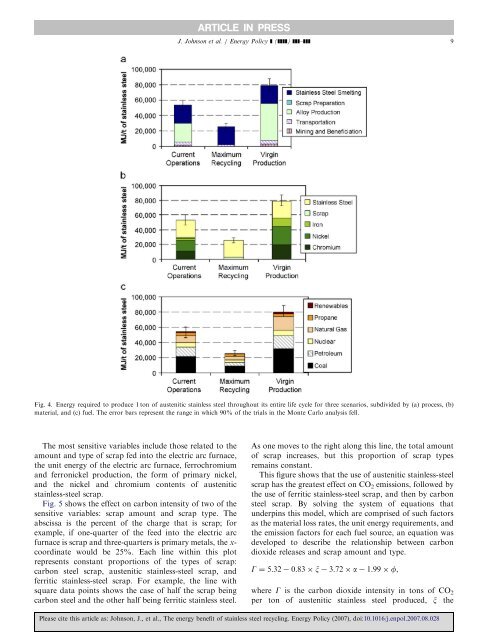The energy benefit of stainless steel recycling - British Stainless ...
The energy benefit of stainless steel recycling - British Stainless ... The energy benefit of stainless steel recycling - British Stainless ...
8 ARTICLE IN PRESS J. Johnson et al. / Energy Policy ] (]]]]) ]]]–]]] Fig. 3. Primary energy required to produce 1 ton of austenitic stainless steel, ca. early 2000s, under (a) Current Operations, (b) Maximum Recycling, and (c) Virgin Production. Units are MJ/ton stainless steel. Totals may not be additive due to rounding. Trans ¼ transportation; DRI ¼ direct reduced iron; FeCr ¼ ferrochromium; FeNi ¼ ferronickel; and NiO ¼ nickel oxide. Please cite this article as: Johnson, J., et al., The energy benefit of stainless steel recycling. Energy Policy (2007), doi:10.1016/j.enpol.2007.08.028
ARTICLE IN PRESS J. Johnson et al. / Energy Policy ] (]]]]) ]]]–]]] 9 Fig. 4. Energy required to produce 1 ton of austenitic stainless steel throughout its entire life cycle for three scenarios, subdivided by (a) process, (b) material, and (c) fuel. The error bars represent the range in which 90% of the trials in the Monte Carlo analysis fell. The most sensitive variables include those related to the amount and type of scrap fed into the electric arc furnace, the unit energy of the electric arc furnace, ferrochromium and ferronickel production, the form of primary nickel, and the nickel and chromium contents of austenitic stainless-steel scrap. Fig. 5 shows the effect on carbon intensity of two of the sensitive variables: scrap amount and scrap type. The abscissa is the percent of the charge that is scrap; for example, if one-quarter of the feed into the electric arc furnace is scrap and three-quarters is primary metals, the x- coordinate would be 25%. Each line within this plot represents constant proportions of the types of scrap: carbon steel scrap, austenitic stainless-steel scrap, and ferritic stainless-steel scrap. For example, the line with square data points shows the case of half the scrap being carbon steel and the other half being ferritic stainless steel. As one moves to the right along this line, the total amount of scrap increases, but this proportion of scrap types remains constant. This figure shows that the use of austenitic stainless-steel scrap has the greatest effect on CO 2 emissions, followed by the use of ferritic stainless-steel scrap, and then by carbon steel scrap. By solving the system of equations that underpins this model, which are comprised of such factors as the material loss rates, the unit energy requirements, and the emission factors for each fuel source, an equation was developed to describe the relationship between carbon dioxide releases and scrap amount and type. G ¼ 5:32 0:83 x 3:72 a 1:99 f, where G is the carbon dioxide intensity in tons of CO 2 per ton of austenitic stainless steel produced, x the Please cite this article as: Johnson, J., et al., The energy benefit of stainless steel recycling. Energy Policy (2007), doi:10.1016/j.enpol.2007.08.028
- Page 1 and 2: ARTICLE IN PRESS Energy Policy ] (]
- Page 3 and 4: ARTICLE IN PRESS J. Johnson et al.
- Page 5 and 6: ARTICLE IN PRESS J. Johnson et al.
- Page 7: ARTICLE IN PRESS J. Johnson et al.
- Page 11 and 12: ARTICLE IN PRESS J. Johnson et al.
ARTICLE IN PRESS<br />
J. Johnson et al. / Energy Policy ] (]]]]) ]]]–]]] 9<br />
Fig. 4. Energy required to produce 1 ton <strong>of</strong> austenitic <strong>stainless</strong> <strong>steel</strong> throughout its entire life cycle for three scenarios, subdivided by (a) process, (b)<br />
material, and (c) fuel. <strong>The</strong> error bars represent the range in which 90% <strong>of</strong> the trials in the Monte Carlo analysis fell.<br />
<strong>The</strong> most sensitive variables include those related to the<br />
amount and type <strong>of</strong> scrap fed into the electric arc furnace,<br />
the unit <strong>energy</strong> <strong>of</strong> the electric arc furnace, ferrochromium<br />
and ferronickel production, the form <strong>of</strong> primary nickel,<br />
and the nickel and chromium contents <strong>of</strong> austenitic<br />
<strong>stainless</strong>-<strong>steel</strong> scrap.<br />
Fig. 5 shows the effect on carbon intensity <strong>of</strong> two <strong>of</strong> the<br />
sensitive variables: scrap amount and scrap type. <strong>The</strong><br />
abscissa is the percent <strong>of</strong> the charge that is scrap; for<br />
example, if one-quarter <strong>of</strong> the feed into the electric arc<br />
furnace is scrap and three-quarters is primary metals, the x-<br />
coordinate would be 25%. Each line within this plot<br />
represents constant proportions <strong>of</strong> the types <strong>of</strong> scrap:<br />
carbon <strong>steel</strong> scrap, austenitic <strong>stainless</strong>-<strong>steel</strong> scrap, and<br />
ferritic <strong>stainless</strong>-<strong>steel</strong> scrap. For example, the line with<br />
square data points shows the case <strong>of</strong> half the scrap being<br />
carbon <strong>steel</strong> and the other half being ferritic <strong>stainless</strong> <strong>steel</strong>.<br />
As one moves to the right along this line, the total amount<br />
<strong>of</strong> scrap increases, but this proportion <strong>of</strong> scrap types<br />
remains constant.<br />
This figure shows that the use <strong>of</strong> austenitic <strong>stainless</strong>-<strong>steel</strong><br />
scrap has the greatest effect on CO 2 emissions, followed by<br />
the use <strong>of</strong> ferritic <strong>stainless</strong>-<strong>steel</strong> scrap, and then by carbon<br />
<strong>steel</strong> scrap. By solving the system <strong>of</strong> equations that<br />
underpins this model, which are comprised <strong>of</strong> such factors<br />
as the material loss rates, the unit <strong>energy</strong> requirements, and<br />
the emission factors for each fuel source, an equation was<br />
developed to describe the relationship between carbon<br />
dioxide releases and scrap amount and type.<br />
G ¼ 5:32 0:83 x 3:72 a 1:99 f,<br />
where G is the carbon dioxide intensity in tons <strong>of</strong> CO 2<br />
per ton <strong>of</strong> austenitic <strong>stainless</strong> <strong>steel</strong> produced, x the<br />
Please cite this article as: Johnson, J., et al., <strong>The</strong> <strong>energy</strong> <strong>benefit</strong> <strong>of</strong> <strong>stainless</strong> <strong>steel</strong> <strong>recycling</strong>. Energy Policy (2007), doi:10.1016/j.enpol.2007.08.028



